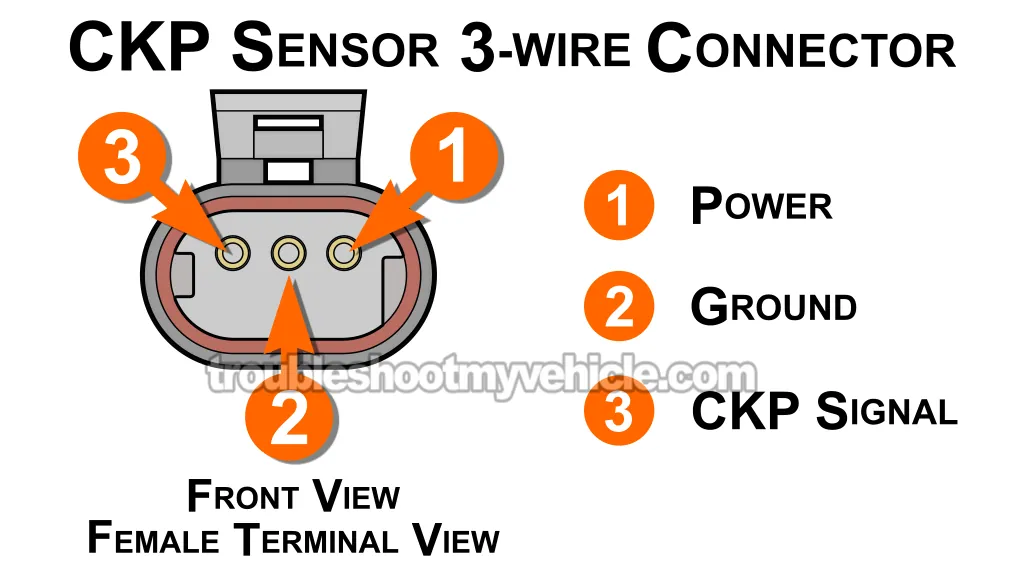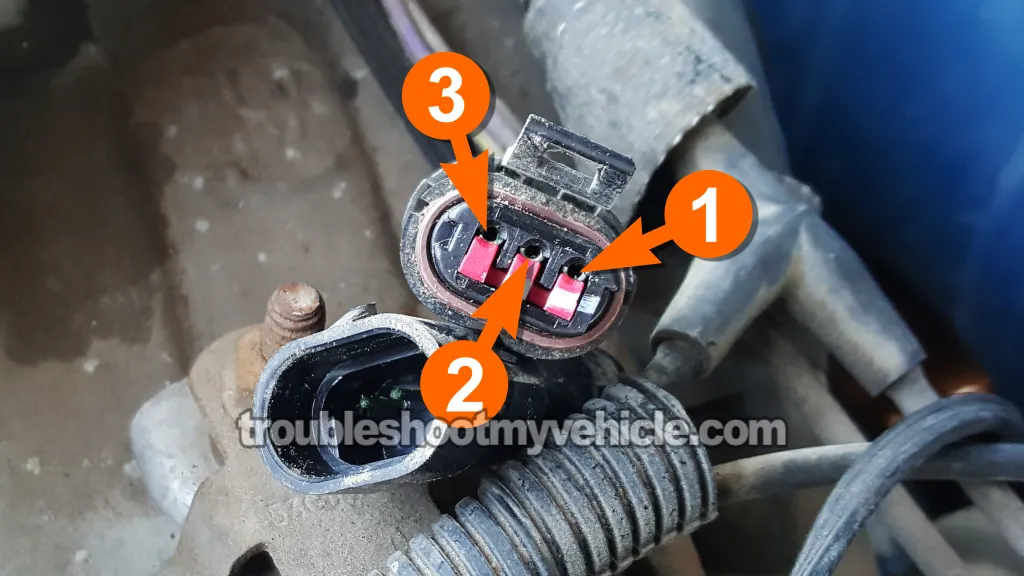
The crankshaft position (CKP) sensor plays a big role in your 3.9L V6 Dodge Ram pickup's ignition system. The cool thing is that testing it, to see if it's good or bad, can easily be done with just a multimeter.
In this tutorial, I'm gonna show you my way of checking it with 3 simple multimeter tests. With your test results, you'll quickly find out if it's functioning correctly or if it's toast.
Contents of this tutorial:
- Important Tips And Suggestions.
- How The CKP Sensor Works.
- CKP Sensor Connector Pinout.
- Where To Buy The CKP Sensor And Save.
- TEST 1: Checking The CKP Signal With A Multimeter.
- TEST 2: Making Sure The CKP Sensor Has Power.
- TEST 3: Making Sure The CKP Sensor Has Ground.
- More 3.9L V6 Dodge Ram Pickup Tutorials.
APPLIES TO: This tutorial applies to the following vehicles:
- 3.9L V6 Dodge Ram 150 Pickup: 1992, 1993.
- 3.9L V6 Dodge Ram 250 Pickup: 1992, 1993.
- 3.9L V6 Dodge Ram 1500 Pickup: 1994, 1995, 1996, 1997.
- 3.9L V6 Dodge Ram 2500 Pickup: 1994, 1995, 1996, 1997.
WIRING DIAGRAMS:
- Ignition System Wiring Diagram (1992-1993 3.9L V6 Dodge Ram Pickup).
- Ignition System Wiring Diagram (1994-1995 3.9L V6 Dodge Ram Pickup).
- Ignition System Wiring Diagram (1996-1997 3.9L V6 Dodge Ram Pickup).
IGNITION SYSTEM TESTS:
- How To Test The Ignition Coil (1992-2001 3.9L V6 Dodge Ram Pickup).
- How To Test The Camshaft Position Sensor (1992-1995 3.9L V6 Dodge Ram Pickup).
- How To Test The Camshaft Position Sensor (1996-1997 3.9L V6 Dodge Ram Pickup).
Important Tips And Suggestions
TIP 1 →On-car test: This CKP sensor test is done with it still bolted to the transmission bell housing. Don't remove it to test it.
TIP 2 →Crank the engine by hand (not with the key): To get an accurate multimeter test result, you'll need to rotate the engine manually —not with the starter motor.
This part matters —if you use the starter to crank the engine, the multimeter reading won't be of any use to you.
When I say crank it by hand, I mean grab a 1/2-inch ratchet and the correct socket, then turn the crankshaft pulley yourself.
TIP 3 →Start by checking for spark: This one's a big deal: if you've already confirmed the ignition coil is sparking, the CKP sensor is working just fine.
Spark means the sensor is doing its job, so if that's the case, this CKP test won't tell you anything new.
This tutorial will help you check for spark:
How The CKP Sensor Works

The crankshaft position sensor (CKP) sits on the transmission bell housing. From there, it monitors (senses) the notches on the flywheel as the engine cranks or runs.
- CKP signal: The flywheel has 6 sets of notches arranged in a pattern: 3 sets of single notches and 3 sets of double notches, spaced evenly around its edge. As each set passes under the CKP sensor, it triggers a voltage pulse:
- A single notch creates 1 pulse.
- A double notch (two notches close together) creates 2 fast pulses.
- Purpose: These pulses tell the computer the exact position of the crankshaft and how fast the engine's spinning (RPM). It works together with the cam sensor (CMP) to control spark timing and fuel injection.
- No CKP signal, no-start: If the computer doesn't see those CKP pulses, it shuts down the ASD (Auto Shutdown) relay and the fuel pump relay. That cuts power to the injectors and ignition coil —and the engine isn't gonna start.
- ON/OFF voltage: As the engine rotates, the sensor flips between ON and OFF. You'll see 5 Volts DC when it's ON, and 0 Volts when it's OFF.
- When a single notch passes under the sensor, you'll get 1 voltage flip (1 pulse).
- When a double notch passes by, you'll see 2 quick voltage flips (2 pulses).
- Testing: The cool part? You can catch that 5-to-0 Volt flip using a regular multimeter —and that's exactly how we're gonna test it.
CKP Sensor Connector Pinout

| Pin | Wire Color | Description |
|---|---|---|
| 1 | Orange (ORG) | 8 Volts DC →1992-1995 only |
| Violet with white stripe (VIO/WHT) | 5 Volts DC →1996-1997 only | |
| 2 | Black with light blue stripe (BLK/LT BLU) | Sensor Ground |
| 3 | Grey with black stripe (GRY/BLK) | CKP Signal |
Where To Buy The CKP Sensor And Save
If you're not sure if the above CKP sensors fit your particular vehicle, don't worry. Once you get to the site, they'll make sure that it fits and if it doesn't, they'll ask the particulars of your specific Dodge Ram pickup to find you the right one.
TEST 1: Checking The CKP Signal With A Multimeter
The first thing we need to do is check if the CKP sensor is putting out a 5-Volt ON/OFF signal through its signal wire.
The CKP signal wire is the gray with black stripe (GRY/BLK) wire of the CKP sensor's wiring harness connector.
Since the sensor has to stay plugged in during the test, you'll need to tap into the GRY/BLK wire with a special tool.
You've got two ways to do that: back-probe the connector or use a wire-piercing tool. If you're not sure what one looks like or need to buy one, take a look here: Wire Piercing Probe Tool Review (Power Probe PWPPPPP01).
IMPORTANT: Like I said earlier, there's no reason to remove the CKP sensor for this test —and you should not remove it from the engine. If you do, you'll throw off its air gap calibration when you reinstall it and it'll get destroyed when you crank the engine.
NOTE: Need to buy a multimeter or an upgrade? This is the one I have and use: Tekpower TP8268 AC/DC Auto/Manual Range Digital Multimeter (at: amazon.com).
Alright, let's get into it:
- 1
Disconnect the ignition coil from its connector. This is a must-do safety step —don't skip it before moving forward.
- 2
Attach the black test lead from your multimeter to the negative (-) terminal on the battery.
- 3
Turn the key to the ON position (but don't start the engine). This "wakes up" the CKP sensor so it's ready to be tested.
- 4
Locate the CKP sensor connector.
Once you've found it, peel back a bit of the plastic loom or tape around the sensor's three wires. You only need enough room to access them for testing.
NOTE: Make sure you've got the right connector. The CMP and CKP sensor connectors look similar. The connector you're after connects to the sensor on the transmission bell housing, not the one inside the distributor. - 5
Switch your multimeter to Volts DC mode.
- 6
Touch the red test lead to the GRY/BLK wire at the CKP sensor harness connector.
This wire connects to terminal number 3 on the sensor —see the diagram above for reference.
NOTE: Keep the CKP sensor plugged in the whole time —unplugging it will mess up the test. - 7
Have someone slowly rotate the crankshaft pulley by hand (clockwise) while you watch the multimeter.
NOTE: Don't use the starter motor, otherwise you won't see the voltages changes (as the engine is turning over too fast). This test only works when the engine's turned by hand. - 8
Watch for the multimeter to flip between 0 and 5 Volts as you slowly turn the crankshaft pulley.
OFF = 0 Volts. ON = 5 Volts. Crank the engine smoothly and steadily so you don't miss any voltage changes.
NOTE: You should catch a total of 6 sets of voltage flips for each full rotation of the crankshaft: 3 single flips and 3 double flips.
→ A single flip happens when a single notch on the flywheel passes under the sensor and you'll see the voltage jump once (from 0 to 5 or vice versa).
→ A double flip happens when a pair of notches (double notch set) passes by —you'll see the voltage flip twice in quick succession.
These flips are the sensor's ON/OFF pulses, and they're what the PCM uses to track crankshaft position.
Now, let's go over what your test results mean:
CASE 1: The multimeter flipped between 5 Volts and 0 Volts as you turned the crank. That means the CKP sensor is working like it should.
If the sensor's doing its job, the no-start issue is coming from somewhere else. Next place to check is the camshaft position (CMP) sensor. Start here:
- How To Test The Camshaft Position Sensor (1992-1995 3.9L V6 Dodge Ram Pickup).
- How To Test The Camshaft Position Sensor (1996-1997 3.9L V6 Dodge Ram Pickup).
- How To Test The Camshaft Position Sensor (1998-2001 3.9L V6 Dodge Ram Pickup).
CASE 2: The multimeter didn't show any ON/OFF 5-Volt signal while cranking the engine by hand. That tells you the CKP sensor isn't sending a signal to the PCM —so no spark and no fuel injection.
In about 95% of cases, this means the CKP sensor is toast. Replacing it usually gets things running again. But —not always.
Before calling it for sure, double-check that the sensor's actually getting power from the PCM. That's your next step: TEST 2: Making Sure The CKP Sensor Has Power.




